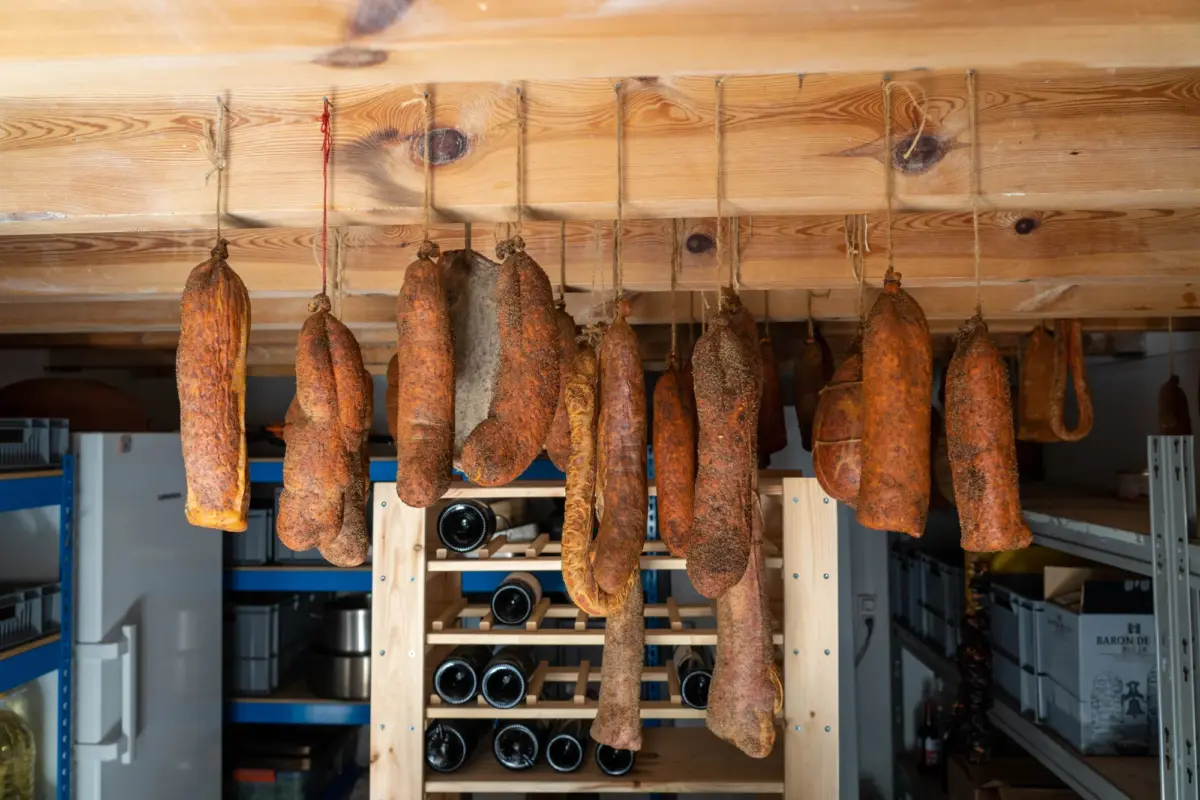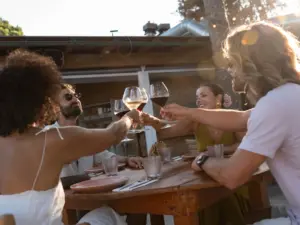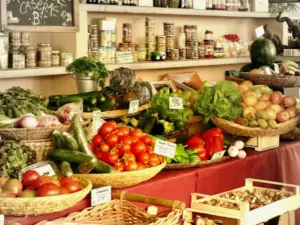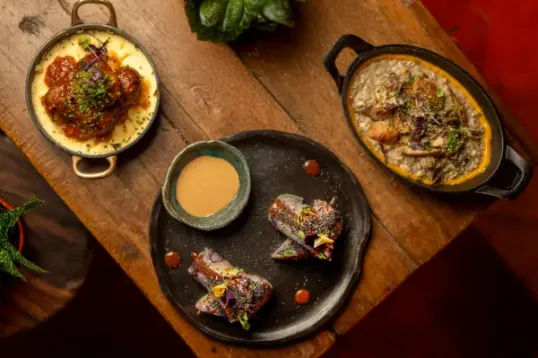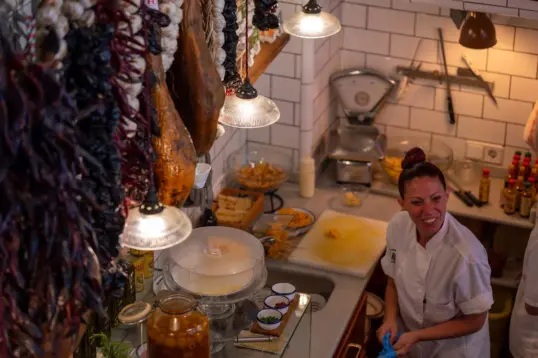There’s something quite satisfying about planning a holiday around what you’ll eat rather than what you’ll see. Mallorca, with its sun-baked hills, sleepy fishing harbours, and fertile farmland, lends itself perfectly to this kind of trip — one where the next meal is as much the destination as the town it’s served in.
Rather than treating food as an add-on to the itinerary, why not let it lead the way?
Let the seasons decide
If you really want to eat well in Mallorca, start by thinking about when to go. The island’s food follows the rhythm of the land and sea, and what’s on your plate can vary a great deal depending on the time of year.
Spring brings wild herbs, fresh peas, and tender lamb. Come summer, everything bursts to life — tomatoes, aubergines, peaches, seafood caught at dawn. Autumn is harvest time, with vineyards and olive groves in full swing. In winter, traditional comfort food takes over — rich stews, slow-cooked rice dishes, and warming liqueurs made from fennel, citrus peel and mint.
Late April to early June or mid-September are ideal for food lovers. The markets are overflowing, but the crowds are thinner, and the weather is still more than kind.
Beyond the city limits
Palma is a natural starting point. It’s got style, fantastic bakeries, wine bars hidden down old stone lanes, and an energetic restaurant scene that ranges from cutting-edge to classic. You’ll find everything from modern tasting menus to family-run spots where lunch is still sacred.
But for the real flavour of the island, you’ll want to get out of town.
Up in the Tramuntana mountains, villages like Fornalutx and Deià serve food that reflects the land itself — earthy, honest, and rooted in tradition. Along the coast, towns like Portocolom or Cala Figuera offer seafood so fresh it barely hits the plate before it’s gone. Inland, around towns like Binissalem or Santa Maria, you’ll find hearty country dishes and some very drinkable local wines.
The variety is impressive — from wood-fired bread in a village square to elegant seafood eaten with a sea breeze and a glass of chilled rosé.
Find the markets, meet the makers
Mallorca’s markets aren’t just for tourists; they’re where the locals shop, eat and gather.
Head to Mercat de l’Olivar in Palma for a lively introduction to island produce — cheeses, olives, salt-cured fish, the famous sobrasada, and plenty more. If you’re staying in the mountains, Sóller’s Saturday market is worth visiting — not too big, full of local colour, and set in a gorgeous town square.
Inca’s Thursday market is the largest on the island and ideal if you’re after something a little less polished. You’ll find charcuterie, spices, honey, wines, fresh vegetables and all sorts of useful ingredients if you fancy cooking a bit yourself.
Better still, join a local guide for a private food tour. At Food Tours Mallorca, some tours include market visits followed by cooking classes, giving you the chance to shop, taste, and cook like a local. It’s a brilliant way to get under the skin of Mallorcan cuisine.
A different pace of eating
You quickly realise, once on the island, that people here treat mealtimes with a kind of quiet respect. Lunch is rarely rushed. Dinner might not start until nine. And no one’s checking the time.
Start your day with something simple — perhaps a flaky ensaimada and a strong coffee at a pavement café. Mid-morning? Maybe a slice of coca de trempó — a sort of Mallorcan flatbread topped with peppers and tomato.
Lunch is often the main meal of the day. It could be a long, lazy seafood feast by the sea, or a hearty mountain stew of rabbit and potatoes, washed down with a glass of local red. In the afternoon, life slows right down. Many places close for a few hours. Take a nap, go for a swim, or wander until dinner calls.
In the evening, tapas or a light shared meal is often just right — olives, bread, grilled vegetables, perhaps some fresh calamari or anchovies, a bottle of wine, and good company.
Know what’s worth ordering
Mallorcan food is generous, rustic and made with care. If you’re new to the island’s dishes, here are a few worth looking out for:
- Arroz brut: A spiced, brothy rice dish made with meat and seasonal vegetables — comforting and deeply satisfying.
- Tumbet: Layers of fried aubergine, potato and courgette, topped with a fresh tomato sauce — a bit like a Mediterranean lasagne without the pasta.
- Frito mallorquín: A punchy mix of offal, potatoes, and vegetables — not for the faint-hearted, but rich in flavour and tradition.
- Pa amb oli: Simple but never boring — country bread rubbed with tomato and drizzled with olive oil, often topped with cheese or ham.
- Sobrasada: A soft, paprika-spiced sausage — wonderful spread on warm bread or used in cooking.
Pair your meals with local wines — the island has some excellent vineyards — or try a glass of hierbas, a digestif made from local herbs.
A few hidden tables
You’ll find brilliant food all over Mallorca, from backstreet tapas bars to sea-facing terraces. But here are a few lesser-known spots that keep getting whispered about:
- Ca Na Toneta in Caimari — fiercely local, run by sisters, with a real focus on sustainable, seasonal food.
- Es Taller in Valldemossa — housed in a former garage, offering creative dishes that still feel rooted in the island.
- Bodega Can Ribas in Consell — book ahead for a long, peaceful lunch among the vines.
And don’t overlook the casual, family-run places where no one speaks English and the menu changes daily. That’s often where the magic happens.
Don’t plan too much
It might sound odd coming from someone encouraging you to build your trip around food, but don’t over-plan. Leave room for the unexpected — the tiny beach bar with grilled sardines and a €10 carafe of wine, the bakery that smells too good to walk past, or the restaurant you hadn’t heard of but can’t stop talking about.
Mallorca rewards the curious. The ones who take the wrong turn or follow their nose instead of the guidebook. Ask locals. Trust your instincts. Eat when you’re hungry. Rest when you’re not.
The island has a gentle rhythm — food is part of it, not separate from it. Meals aren’t events here; they’re just what you do, when the time feels right.
A final thought
Planning a food-based holiday isn’t about eating fancy for a week. It’s about tuning into a place through its ingredients, its traditions, and the people who keep them alive. In Mallorca, that comes naturally.
So come hungry — but also come open. Let flavour shape your days. Trust long lunches, unplanned detours, and dishes you can’t quite pronounce. That’s where the stories are.
To start planning your own flavour-first trip, browse our Mallorca food tours and let the island’s cuisine lead the way.



